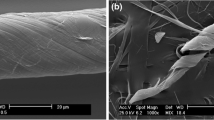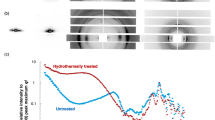Abstract
Wood cell walls when contacted with humid atmosphere or an aqueous solution containing electrolytes or polymers undergo the phenomenon of swelling. In this work, experimental data were produced to quantify the effects of the adsorption water and solutes, which were introduced in the material by equilibration with a solution used as osmotic reservoir. For this reason, different environmental setups have been developed, allowing the control of temperature, water chemical potential, and ionic strength during the sorption process. The aim of this paper is to describe three experimental setups, focused on different levels: at the nanometric scale, small-angle scattering at controlled humidity; at the mesoscopic scale, environmental scanning electron microscopy; and at the macroscopic scale, tensile stage involving immersion of samples in solutions. Applicability and efficiency of the three setups are described. Moreover, it was shown how the combination of the results obtained via the three methodologies can be compared to expectations from a general Equation of State (EOS approach), where wood swelling with water and salt solutions is presented as the dependence of the distance between adjacent cellulose fibrils on the osmotic pressure. The total pressure calculated takes into account chemical, colloidal and mechanical terms in the force balance of the wood cell wall.












Similar content being viewed by others
References
Altaner C, Apperley DC, Jarvis MC (2006) Spatial relationships between polymers in Sitka spruce: proton spin-diffusion studies. Holzforschung 60:665–673
Alves L, Medronho B, Antunes FE, Lindman B (2016) Dissolution state of cellulose in aqueous system- 2 acidic solvents. Carbohydr Polym 20(151):707–715
Baer MD, Mundy CJ (2013) An ab initio approach to understanding the specific ion effect. Faraday Discuss 160:89–101
Barbetta A, Bertinetti L, Zemb T (2017a) Composition dependent Equation of State of cellulose based plant tissues in the presence of electrolytes. Colloids Surf A Physicochem Eng Asp 532:314–322. https://doi.org/10.1016/j.colsurfa.2017.04.075
Barbetta A, Fratzl P, Zemb T, Bertinetti L (2017b) Impregnation and swelling of wood with salts: ion specific kinetics and thermodynamics effects. Adv Mater Interfaces 4:1600437. https://doi.org/10.1002/admi.201600437
Beckers EPJ, de Meijer M, Militz H, Stevens M (1998) Performance of finishes on wood that is chemically modified by acetylation. J Coat Technol 70(878):59–67
Bernabei M, Salvatici MC (2016) In situ ESEM observations of spruce wood (Picea abies Karst.) during heat treatment. Wood Sci Technol 50:715–726
Bertinetti L, Fischer FD, Fratzl P (2013) Physicochemical basis for water-actuated movement and stress generation in nonliving plant tissues. Phys Rev Lett 11:238001
Bertinetti L, Masic A, Schuetz R, Barbetta A, Seidt B, Wagermaier W, Fratzl P (2015) Osmotically driven tensile stress in collagen-based mineralized tissues. J Mech Behav Biomed Mater 52:14–21
Bertinetti L, Fratzl P, Zemb T (2016) Chemical, colloidal and mechanical contributions to the state of water in wood cell walls. New J Phys 18:083048
Chang S, Quignard F, Di Renzo F, Clair B (2012) Solvent polarity and internal stresses control the swelling behavior of green wood during dehydration in organic solution. BioResources 7:2418–2430
Eder M, Stanzl-Tschegg S, Burgert I (2008) The fracture behaviour of single wood fibers is governed by geometrical constraints: in situ ESEM studies on three fiber types. Wood Sci Technol 42:679–689
Elbaum R, Gorb S, Fratzl P (2008) Structures in the cell wall that enable hygroscopic movement of wheat awns. J Struct Biol 164:101–107
Elustondo DM, Oliveira L, Avramidis S (2010) New methodology to optimize sorting in wood drying. Maderas Cienc Tecnol 12(2):79–91
Fengel D, Wegener G (2003) Wood–chemistry, ultrastructure, reactions. Verlag Kessel, Remagen, pp 26–59, 227–238, 296–315
Fernandes AN, Thomas LH, Altaner CM, Callow P, Firsyth VT, Apperley DC, Kennedy CK, Jarvis MC (2011) Nanostructure of cellulose microfibrils in spruce wood. PNAS 108(47):E1195–E1203
Fratzl F, Barth FG (2009) Biomaterial systems for mechanosensing and actuation. Nature 462:442–448
Fratzl P, Weinkamer R (2007) Nature’s hierarchical materials. Prog Mater Sci 52:1263–1334
Fratzl P, Elbaum R, Burgert I (2009) Cellulose fibrils direct plant organ movements. Faraday Discuss 139:275–282
Gorisek Z, Torelli N (1999) Microfibril angle in juvenile, adult and compression wood of spruce and silver fir. Phyton 39(3):129–132
Heymann E, McKillop GC (1939) Studies on the lyotropic series. III The adsorption of salts on cellulose. J Phys Chem 45(2):195–203
Heymann E, Bleakley HG, Docking AR (1937) Studies on the lyotropic series. I The adsorption of salts on methylcellulose. J Phys Chem 42(3):353–368
Hill CAS, Norton A, Newman G (2009) The water vapor sorption behavior of natural fibers. J Appl Polym Sci 112:1524–1537
Jakob HF, Tschegg SE, Fratzl P (1996) Hydration dependence of the wood-cell wall structure in Picea abies. A small-angle X-ray scattering study. Marcomolecules 29:8435–8440
Jendrasiak GL, Mendible JC (1976) The effect of the phase transition on the hydration and electrical conductivity of phospholipids. Biochim Biophys Acta 424:133–148
Kazi KMF, Jollez P, Chornet E (1998) Preimpregnation: an important step for biomass refining processes. Biomass Bioenergy 15(2):125–141
LeNeveu DM, Rand RP, Parsegian VA, Gingell D (1977) Measurement and modification of forces between lecithin bilayers. Biophys J 18:209–230
Mantanis GI (2017) Chemical modification of wood by acetylation or furfurylation: a review of the present scaled-up technologies. BioResources 12(2):4478–4489
Mathias LJ, Lee S, Wright JR, Warren SC (1991) Improvement of wood properties by impregnation with multifunctional monomers. J Appl Polym Sci 42:55–67
Medronho B, Lindman B (2014) Competing forces during cellulose dissolution: from solvents to mechanisms. COCIS 19(1):32–40
Medronho B, Romano A, Graça Miguel M, Stigsson L, Lindman B (2012) Rationalizing cellulose (in)solubility: reviewing basic physicochemical aspects and role of hydrophilic interactions. Cellulose 19:581–587
Murata K, Watanabe Y, Nakano T (2013) Effect of thermal treatment on fracture properties and adsorption properties of spruce wood. Materials 6:4186–4197
Onuki A, Okamoto R, Araki T (2011) Phase transitions in soft matter induced by selective solvation. Bull Chem Soc Jpn 84(6):569–587
Parsegian VA, Zemb T (2011) Hydration forces: observations, explanations, expectations, questions. COCIS 16:618–624
Podgornik R, Parsegian VA (1997) On a possible microscopic mechanism underlying the vapor pressure paradox. Biophys J 72:942–952
Podgornik R, Strey HH, Parsegian VA (1977) Colloidal DNA. Biophys J 18:209–230
Poulanne E, Halonen M (2010) Theoretical aspects of water-holding in meat. Meat Sci 86:151–165
Rahim KA, Huque MM (1966) Swelling of cellulose in salt solutions and its relation to the radii of ions. J Text I 57(8):T374–T376
Rand RP, Parsegian VA (1989) Hydration forces between phospholipid bilayers. Biochim Biophys Acta 988:351–376
Redman AL, Bailleres H, Turner I, Perré P (2016) Characterisation of wood-water relationships and transverse anatomy and their relationship to drying degrade. Wood Sci Technol 50:739–757
Rowell RM (2014) Acetylation of wood—a review. Int J Lignocellulosic Prod 1:1–27
Salmén L (2004) Micromechanical understanding of the cell-wall structure. Biologies 327:873–880
Schindelin J, Arganda-Carreras I, Frise E, Kaynig V, Longair M, Pietzsch T, Preibisch S, Rueden C, Saafeld S, Schmid B, Tinevez JY, White DJ, Hartenstein V, Eliceiri K, Tomancak P, Cardona A (2012) Fiji: an open-source platform for biological-image analysis. Nat Methods 9:676–682
Singh P, Duarte H, Alves L, Antunes F, Le Moigne N, Dormanns J, Duchemin B, Staiger MP, Medronho B (2015) From cellulose dissolution and regeneration to added value applications—synergism between molecular understanding and material development. Cellulose—fundamental aspects and current trends. InTech Chapter 1, pp 1–44
Tristram-Nagle S, Petrache HI, Suter RM, Nagle JF (1998) Effect of substrate roughness on D spacing supports theoretical resolution of vapor pressure paradox. Biophys J 74:1421–1427
Turkulin H, Holzer L, Richter K (2004a) Application of the ESEM technique in wood research. Part I. Optimization of imaging parameters and working conditions. Wood Fiber Sci 37(4):552–564
Turkulin H, Holzer L, Richter K (2004b) Application of the ESEM technique in wood research. Part II. Comparison of operational models. Wood Fiber Sci 37(4):565–573
Volkova N, Ibrahim V, Hatti-Kaul R, Wadsö L (2012) Water sorption isotherms of Kraft lignin and its composites. Carbohydr Polym 87:1817–1821
Wallström L, Lindberg KAH (2000) The diffusion, size and location of added silver grains in the cell walls of Swedish pine, Pinus sylvestris. Wood Sci Technol 34:403–415
Weinkamer R, Fratzl P (2011) Mechanical adaptation of biological materials—the examples of bone and wood. Mater Sci Eng 31:1161–1173
Whitney SEC, Brigham JE, Darke AH, Grant Reid JS, Gidley MJ (1998) Structural aspects of the interaction of mannan-based polysaccharides with bacterial cellulose. Carbohydr Res 307:299–309
Acknowledgements
The authors thank Klaus Bienert and Marco Bott, Max Planck Institute of Colloids and Interfaces, for technical support and development of the in situ mechanical testing devices, Stefan Siegel and Chenghao Li for their support during the X-ray measurements at the μ-spot beam line (BESSY II, Helmholtz–Zentrum für Materialien und Energie, Berlin, Germany). The excellence laboratory LABEX “Chemisyst” ANR 2011-05 is acknowledged for the French–German Ph.D. Stipendium. TZ acknowledges the Humboldt foundation for support. The financial support by DFG through Leibniz Award to PF is also acknowledged. This work was fully undertaken within the scope of the French–German agreement L.I.A. RECYCLING between CNRS/INC and MPG/MPIKG. The authors thank Helmuth Möhwald for numerous helpful discussions.
Author information
Authors and Affiliations
Corresponding author
Electronic supplementary material
Below is the link to the electronic supplementary material.
Rights and permissions
About this article
Cite this article
Barbetta, A., Bertinetti, L., Lautru, J. et al. Nano-, meso- and macro-swelling characterization of impregnated compression wood cell walls. Wood Sci Technol 52, 421–443 (2018). https://doi.org/10.1007/s00226-017-0978-6
Received:
Published:
Issue Date:
DOI: https://doi.org/10.1007/s00226-017-0978-6




